SEO stands for search engine optimization, which is a set of practices designed to improve the appearance and positioning of web pages in organic search results. Basically, SEO determines how high you appear in search engine result pages (SERP) like Google or Bing (excluding the paid ad search results).
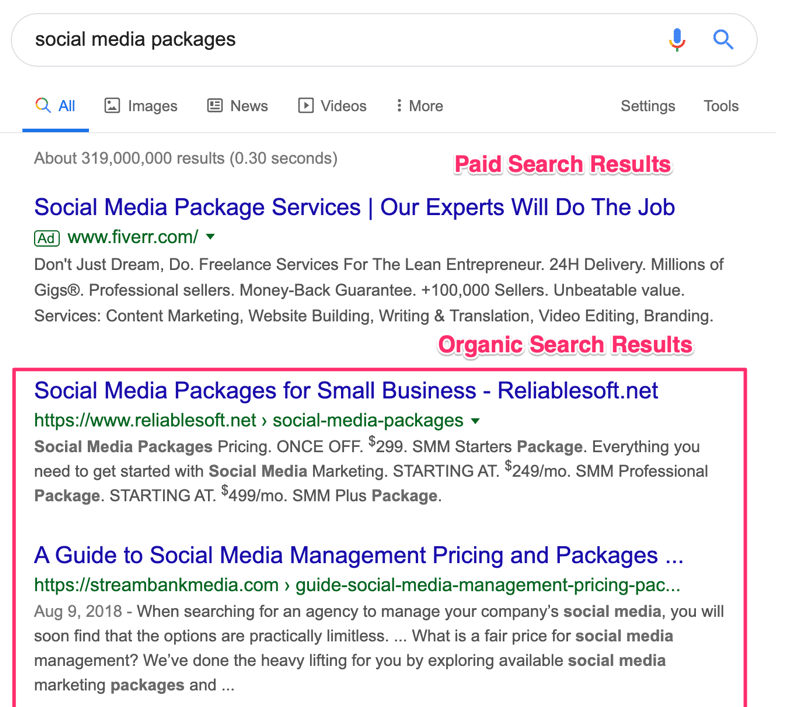
With 68% of online experiences beginning on a search engine, organic search is the most prominent way for people to discover and access online content. This makes a good SEO strategy essential for improving the quality and quantity of traffic to your website.
How do you do SEO?
1. Perform keyword research.
The first step to any great SEO plan is keyword research surrounding the products and services your business provides. Searching for relevant keywords is as simple as typing your product, service, industry, etc. into a keyword tool.
There are many SEO tools available across the web. A popular SEO leader with free tools is Moz.com. There you can find a keyword explorer tool and many other tools for SEO research including a competitive research tool and domain research tool.
A tool from Moz that can be especially useful is the My Online Presence tool. If you are a business with one or more physical locations, including localized SEO with geographic clues like including addresses in footers and creating landing pages for all areas you serve will likely be strategies your business implements. My Online Presence is a tool specifically designed for optimizing this kind of local SEO and help your website rank higher within local search results and directories.
Another SEO leader with a free keyword research tool is SEMRush. If you’re willing to pay for their premier services, SEMRush can provide full audit reports with everything you would ever need to know about your website’s technical SEO. This includes everything from identifying problems like broken links and images missing alt text to letting you know which pages are missing external or internal links and so much more.
Once you have your SEO keyword research tool picked out, your next step is as simple as searching for the products and services you provide within the tool. Once you do so, your keyword tool will spit out a list of keywords (usually organized by highest-lowest monthly search volume). From there, you’ll primarily want to pay attention to two things: volume and difficulty. “Volume” refers to how many searches a specific keyword or phrase receives in a month. “Difficulty” refers to how hard it will be to rank for a keyword based on competition for that keyword. Generally speaking, the higher the volume, the higher the difficulty, but you may be able to find a keyword that has a nice balance between the two.
At MINDSCAPE, some of our popular services include marketing automation, web design, digital advertising, and SEO. When searching for keywords, you’ll want to account for the variety of ways people could be searching for similar keywords. For example, if we were trying to optimize our website design page for search engines we might consider web design, website design, web design agency, website design and development, etc. We would then choose our target keyword based on monthly traffic, difficulty, and the intent behind the keyword.
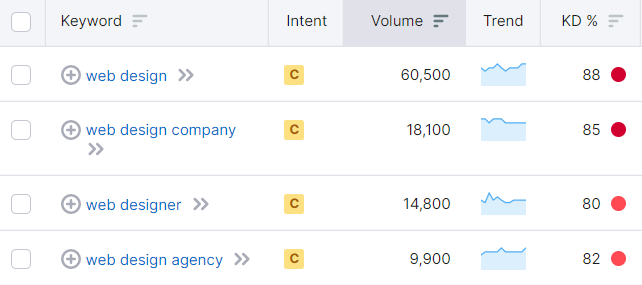
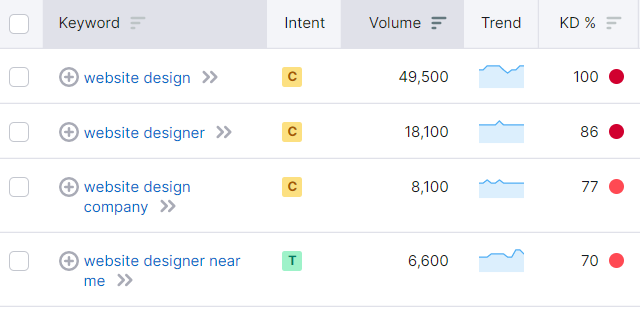
As you can see, ‘web design’ ranks about 22% higher in volume compared to ‘website design’. The difficulty is expressed in the KD% or Keyword Difficulty Percentage. The higher the KD%, the more difficult it will be to rank highly for those keywords. With a higher volume and slightly lower KD%, we would most likely choose “web design” as our target keyword.
A powerful way to use these keyword research tools is to find other high value keywords that are often searched along with your primary relevant keywords. In the web design example, both the ‘web design’ and ‘website design’ rated highly being searched along with the keyword ‘company’. This should be a clue that a piece of content with the keywords ‘web’, ‘design’, and ‘company’ would be flagged as an SEO friendly piece of content because its keywords line up with what the people are actually looking for.
2. Create content around target keywords.
With SEO, the volume of content you have related to a single keyword can be very important. Depending on your competition, Google’s crawlers may not notice your website or rank it highly if there is only one page of content related to the topic on your website. Google will not punish you for reinforcing what you’re all about — as long as you are creating quality content.
Keyword research continues to play a role when generating content because high volume, low difficulty target keywords should be the driving force behind creating an SEO friendly website. For example, don’t be afraid to have separate pieces of content ranking for “web design company,” “web design service,” and “web design near me.” Web design company might be chosen for your home page, web design services for your services page, and web design near me for your contact us page. These pieces of content all serve a different purpose of attracting different target keywords while continually reinforcing web design. This is all extremely positive for SEO rankings.
Another place you can find information about SEO keywords and which content to produce is in the ‘People also ask’ section on Google. Let’s pretend you’re a baking company who intends to create a dinner roll landing page to generate internal links and promote positive SEO. When you Google ‘Roll’, these are the questions that appear:
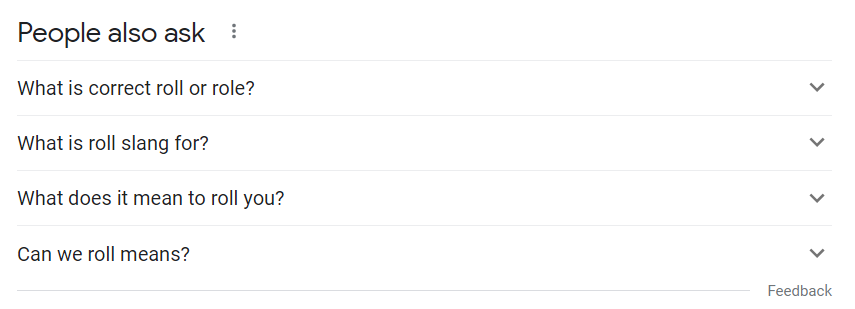
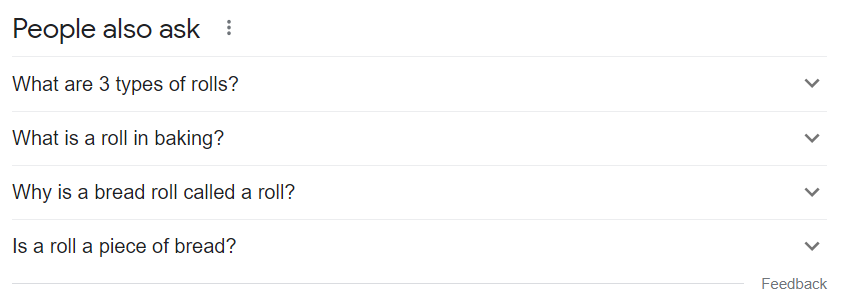
With this information, you now know that Google is optimizing for bakery content under ‘rolls’ instead of ‘roll’. This means the keywords used in the title and headings of this landing page would perform best under “rolls” rather than “roll.” To take this even further, adding the modifier of “dinner” to the beginning of either phrase would add context to the keyword and would likely be a more appropriate search term to target.
3. Update on-Page SEO elements
When it comes to keywords, you need to go beyond including them in your page content. You need to include the target keywords in the image alt text, SEO title, and meta description as well.
There are tools that can help keep you accountable and make sure you’re executing SEO properly. Many tools could accomplish this but one we recommend is YoastSEO for WordPress. It easily lets you edit the SEO title, meta description, target keywords, url slug, and more all in one place. YoastSEO will grade each page and tell you how well you’re executing on all aspects of SEO from keywords, links, and word count.
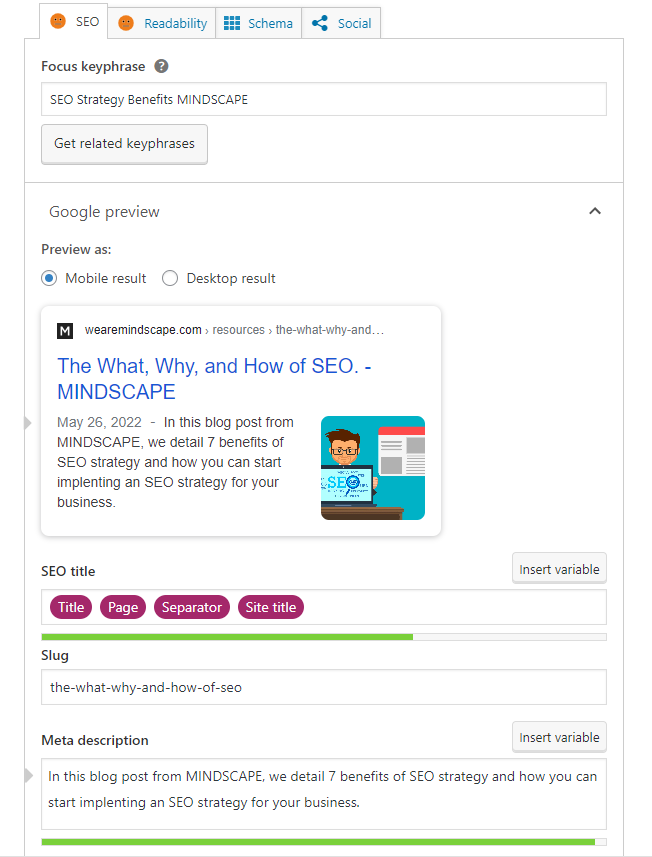
Yoast SEO will also provide a thorough analysis of how well the content is performing with SEO.

4. Link internally and externally.
Another key principle to optimizing SEO is including plenty of both internal and external links. Pages that are essentially islands on the web that are self-contained and lack links elsewhere are not found easily by crawlers. Even when found, pages without trustworthy links are usually not ranked highly.
If a trusted source is linking to your website page, or if you are linking to a trusted source, google is more likely to view your content as reliable. The more relevant content you have linking to a single page on your site, the more authority Google is going to give that page.
When generating internal content, always make sure to link all previous relevant content to your new piece of content. If you have blog posts for “How much does Web Design cost” and “What to look for in a Web Design Agency” and “Should I hire a Web Design Company” and “What goes into Designing a Website” all linking back to your “Web Design Services” page, google knows that the page is valuable and a good hub for info on web design.
5. Optimize for mobile devices.
More than 55% of worldwide internet traffic comes from mobile devices. Search engines like Google have been shifting the focus of their algorithms more and more to support mobile friendly content. This means if your content is not friendly to mobile users, you could get left behind.
The key to generating mobile-friendly content is ensuring that your website pages look great no matter the size of the screen. Users should have a fantastic experience regardless of if they are using a mobile phone, a laptop, or a huge monitor. You want a responsive website where formatting is automatically adjusted based on the size of screen a user is utilizing. There are tools that can help visualize your search results on mobile devices. These tools advise the optimal word counts for your titles, page descriptions, and content across all devices. The previously mentioned Yoast SEO plugin for WordPress is a great tool for this but there are many effective tools across all platforms.
6. Perform a technical SEO audit
Technical SEO is often an indicator of the health of your website and can have a dramatic impact on your ranking within search engines. Poor technical SEO on a site often comes from poor site speed, media with too large file sizes, link redirects, broken images, and more.
Luckily, there are tools that can help you easily identify these exact problems. The tool SEMRush that we mentioned for keyword research is also capable of performing full audits that point you to precisely where every technical SEO issue is on your website. This is a premium feature on SEMRush so it’s not accessible to the average user but performing this kind of audit is a service we provide at MINDSCAPE.
Get started today!
There are a lot of moving parts with SEO and improving the SEO of any website is always an ongoing, evolving process. SEO is most effective when continuously improved upon because the crawlers will notice the changes. There’s no time like the present to get started.
SEO is a specialty of ours at MINDSCAPE so if you have questions about optimizing your website for SEO, feel free to reach out to us!





